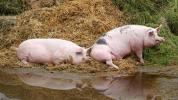H2020 ClearFarm Project: Co-designed welfare monitoring platform for pigs and dairy cattle
- Type Project
- Status Filled
- Execution 2019 -2024
- Assigned Budget 5.899.105,63 €
- Scope Europeo
- Main source of financing Horizon 2020
- Project website ClearFarm
Dairy cows and pigs represent the two livestock production systems with the largest market share in Europe. While animal welfare is widely recognized as essential for sustainable agriculture, existing tools for assessing it are too slow and expensive. Precision livestock farming (PHF) technology offers better control and optimizes livestock processes.
The EU-funded ClearFarm project aims to use GTP technology in conjunction with animal data to improve animal welfare throughout the production chain. The platform will inform both production stakeholders and consumers about the state of animal welfare in production systems, taking into account geographical differences across Europe.
Animal welfare has become a fundamental aspect of livestock production. Current animal welfare assessment tools typically rely on momentary recordings and cumbersome integration of multiple indicators with different units. Furthermore, existing tools for assessing farm animal welfare are time-consuming and expensive. Precision livestock farming (PLF) technology enables the monitoring and optimization of agricultural processes.
PLF systems generate large volumes of data on farms that can be used to monitor the welfare of pigs and dairy cattle. ClearFarm proposes using PLF technology and the integration of animal data, based on a blockchain approach, to enable improved animal welfare throughout the production chain. This will contribute to improving the sustainable production of pigs and dairy cattle, the two livestock production systems with the largest share in Europe.
ClearFarm aims to co-design, develop, and validate an algorithm-driven software platform that integrates PLF data to provide animal welfare insights, as well as other environmental and economic sustainability information, that will support (i) stakeholders in the production chain and (ii) consumers in decision-making within the pig and dairy value chains. Regulators, consumers, producers, policymakers, among other stakeholders, will be involved in the design of the new solution, thus pursuing a multi-stakeholder approach in most stages of the project.
The software platform will be able to report on the welfare status of a variety of production systems, taking into account geographical divergences within production systems across Europe. The algorithm's output will feed into a user-friendly platform that will be adapted to inform different target audiences. ClearFarm will help producers optimize the production process, but will also allow consumers to gain more insight into the background of animal products, thus providing a better understanding of animal welfare.
A new precision livestock farming platform keeps all stakeholders informed. Holistic data on the welfare, environmental, and economic sustainability of pig and dairy cattle farming is securely shared throughout the value chain for greater transparency and impact. Animal welfare is a growing priority for both farmers and consumers, many of whom consider animal treatment when making decisions. Currently, animal welfare assessments are typically conducted once or twice a year through on-site visits. Increasing the efficiency, effectiveness, and transparency of welfare monitoring requires automated, real-time collection of accurate data through sensors and digitalization. These systems will be especially important for small farms, which lack the same knowledge and resources as larger operations. A wealth of technology exists, especially for cattle farming, but it has been underutilized for a variety of reasons.
The EU-funded ClearFarm project developed a precision livestock farming platform (GAP) for pig and dairy farming using a co-design approach. ‘Design thinking’: Human-centered design As ClearFarm wanted to increase transparency across all parts of the value chain, the team surveyed the needs and preferences of a wide range of stakeholders. A “design thinking” approach to problem-solving and innovation was used to understand stakeholder needs and integrate them with what is technologically feasible and economically viable. Stakeholders included consumers, farmers, agricultural cooperatives, processors and slaughterhouse operators, retailers, consultants and researchers, and animal welfare groups. Furthermore, design thinking is an iterative process.
ClearFarm not only worked closely with these stakeholders during the definition phase, but also obtained their feedback on the first version, which was key to making technical and conceptual improvements more in line with the stakeholders' visions. "One of the main things we learned from the project was that people have mixed feelings about using PLF on farms to assess animal welfare. While they are generally positive about it, they have some concerns about the use of private data and the impact it could have on the human-animal relationship," notes project coordinator Xavier Manteca of the Autonomous University of Barcelona. ClearFarm's PLF platform for pig and dairy cattle farming collaborated with universities, research institutions, and private companies, leveraging the expertise of diverse specialists such as scientists, animal welfare experts, data processors, sensor technologists, sociologists, and environmentalists. He addressed the issue of data sharing with other livestock producers for benchmarking purposes, with auditing and certification organizations, with retailers, with market innovators, with government agencies, and for monitoring purposes.
The result is a functional digital platform that enables stakeholders to provide animal welfare data (AWD) in pig and dairy farming. It integrates data on health, nutrition, well-being, emotional state, and natural behavior, as well as environmental and economic sustainability. “The ClearFarm platform for animal AWD integrates a wealth of data and ensures more efficient data collection and analysis using AI. It enables pioneering harmonized data exchange, connecting stakeholders beyond the farm level in the value chain,” explains Manteca. The future of AWD ClearFarm overcame the significant hurdles of COVID-19 restrictions and produced an unexpectedly high number of peer-reviewed articles.
The team is currently working on integrating the platform into existing dairy cattle welfare assessment programs. In pig farming, where existing technologies were less advanced, the team is developing improved and validated sensors for comprehensive welfare monitoring. However, Manteca concludes: "PLF technology can be extremely useful for assessing welfare, but it will never replace good herd management: a demonstrated affinity and empathy for cattle, combined with patient, stress-free handling."
- UNIVERSITAT AUTONOMA DE BARCELONA (UAB)







